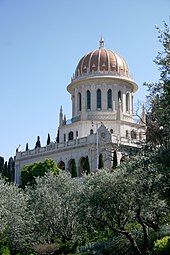Baháʼí Faith
The teachings of Baháʼu’lláh form the foundation of Baháʼí belief. Three principles are central to these teachings: the unity of God, the unity of religion, and the unity of humanity.[18] Baha’is believe that God periodically reveals his will through divine messengers, whose purpose is to transform the character of humankind and to develop, within those who respond, moral and spiritual qualities. Religion is thus seen as orderly, unified, and progressive from age to age.[19]
The Baháʼí Faith is a relatively new religion[a] teaching the essential worth of all religions and the unity of all people.[b] Established by Baháʼu’lláh in the 19th century, it initially developed in Iran and parts of the Middle East, where it has faced ongoing persecution since its inception.[13] The religion is estimated to have 5–8 million adherents, known as Baháʼís, spread throughout most of the world’s countries and territories.[c]
The Baháʼí writings describe a single, personal, inaccessible, omniscient, omnipresent, imperishable, and almighty God who is the creator of all things in the universe.[20] The existence of God and the universe is thought to be eternal, without a beginning or end.[21] Though inaccessible directly, God is nevertheless seen as conscious of creation, with a will and purpose expressed through messengers called Manifestations of God.[22]
Baháʼí teachings state that God is too great for humans to fully comprehend, or to create a complete and accurate image of by themselves. Therefore, human understanding of God is achieved through his revelations via his Manifestations.[23][24][better source needed] In the Baháʼí Faith, God is often referred to by titles and attributes (for example, the All-Powerful, or the All-Loving), and there is a substantial emphasis on monotheism. Baháʼí teachings state that the attributes applied to God are used to translate Godliness into human terms and to help people concentrate on their own attributes in worshipping God to develop their potentialities on their spiritual path.[23][24][better source needed] According to the Baháʼí teachings the human purpose is to learn to know and love God through such methods as prayer, reflection, and being of service to others.[23][better sour
The Baháʼí Faith has three central figures: the Báb (1819–1850), considered a herald who taught his followers that God would soon send a prophet similar to Jesus or Muhammad, and was executed by Iranian authorities in 1850; Baháʼu’lláh (1817–1892), who claimed to be that prophet in 1863 and faced exile and imprisonment for most of his life; and his son, ʻAbdu’l-Bahá (1844–1921), who was released from confinement in 1908 and made teaching trips to Europe and the United States. After ʻAbdu’l-Bahá’s death in 1921, the leadership of the religion fell to his grandson Shoghi Effendi (1897–1957). Baháʼís annually elect local, regional, and national Spiritual Assemblies that govern the religion’s affairs, and every five years an election is held for the Universal House of Justice, the nine-member supreme governing institution of the worldwide Baháʼí community that is located in Haifa, Israel, near the Shrine of the Báb.
According to Baháʼí teachings, religion is revealed in an orderly and progressive way by a single God through Manifestations of God, who are the founders of major world religions throughout history; Buddha, Jesus, and Muhammad are noted as the most recent of these before the Báb and Baháʼu’lláh. Baháʼís regard the world’s major religions as fundamentally unified in purpose, though varied in social practices and interpretations. The Baháʼí Faith stresses the unity of all people, explicitly rejecting racism, sexism, and nationalism. At the heart of Baháʼí teachings is the goal of a unified world order that ensures the prosperity of all nations, races, creeds, and classes.[14][15]
Letters which were written by Baháʼu’lláh and sent to various people, including some heads of state, have been collected and assembled into a canon of Baháʼí scripture. This collection of scripture includes works by his son ʻAbdu’l-Bahá, and the Báb, who is regarded as Baháʼu’lláh’s forerunner. Prominent among the works of Baháʼí literature are the Kitáb-i-Aqdas, the Kitáb-i-Íqán, Some Answered Questions, and The Dawn-Breakers.
https://en.wikipedia.org/wiki/Bah%C3%A1%CA%BC%C3%AD_Faith
Báb[edit]
Shrine of the Báb in Haifa, Israel
On the evening of 22 May 1844, Siyyid ʻAlí-Muhammad of Shiraz gained his first convert and took on the title of “the Báb” (الباب “Gate”), referring to his later claim to the status of Mahdi of Shiʻa Islam.[13] His followers were therefore known as Bábís. As the Báb’s teachings spread, which the Islamic clergy saw as blasphemous, his followers came under increased persecution and torture.[21] The conflicts escalated in several places to military sieges by the Shah‘s army. The Báb himself was imprisoned and eventually executed in 1850.[58]
Baháʼís see the Báb as the forerunner of the Baháʼí Faith, because the Báb’s writings introduced the concept of “He whom God shall make manifest“, a messianic figure whose coming, according to Baháʼís, was announced in the scriptures of all of the world’s great religions, and whom Baháʼu’lláh, the founder of the Baháʼí Faith, claimed to be.[21] The Báb’s tomb, located in Haifa, Israel, is an important place of pilgrimage for Baháʼís. The remains of the Báb were brought secretly from Iran to the Holy Land and eventually interred in the tomb built for them in a spot specifically designated by Baháʼu’lláh.[59] The writings of the Báb are considered inspired scripture by Baháʼís, though having been superseded by the laws and teachings of Baháʼu’lláh.[60] The main written works translated into English of the Báb are compiled in Selections from the Writings of the Báb (1976) out of the estimated 135 works.[61][62]
Baháʼu’lláh[edit]
Mírzá Husayn ʻAlí Núrí was one of the early followers of the Báb, and later took the title of Baháʼu’lláh. Bábís faced a period of persecution that peaked in 1852–53 after a few individual Bábis made a failed attempt to assassinate the Shah. Although they acted alone, the government responded with collective punishment, killing many Bábís. Baháʼu’lláh was put in prison, and, for three days, given neither food nor water, before being exiled.[63][better source needed]
Shortly thereafter he was expelled from Iran and traveled to Baghdad, in the Ottoman Empire.[18] In Baghdad, his leadership revived the persecuted followers of the Báb in Iran, so Iranian authorities requested his removal, which instigated a summons to Constantinople (now Istanbul) from the Ottoman Sultan. In 1863, at the time of his removal from Baghdad, Baháʼu’lláh first announced his claim of prophethood to his family and followers, which he said came to him years earlier while in a dungeon of Tehran.[18] From the time of the initial exile from Iran, tensions grew between him and Subh-i-Azal, the appointed leader of the Bábís, who did not recognize Baháʼu’lláh’s claim. Throughout the rest of his life Baháʼu’lláh gained the allegiance of almost all of the Bábís, who came to be known as Baháʼís, while a remnant of Bábís became known as Azalis.[64]
He spent less than four months in Constantinople. After receiving chastising letters from Baháʼu’lláh, Ottoman authorities turned against him and put him under house arrest in Adrianople (now Edirne), where he remained for four years, until a royal decree of 1868 banished all Bábís to either Cyprus or ʻAkká.
It was in or near the Ottoman penal colony of ʻAkká, in present-day Israel, that Baháʼu’lláh spent the remainder of his life. After initially strict and harsh confinement, he was allowed to live in a home near ʻAkká, while still officially a prisoner of that city.[65] He died there in 1892. Baháʼís regard his resting place at Bahjí as the Qiblih to which they turn in prayer each day.[66]
He produced over 18,000 works in his lifetime, in both Arabic and Persian, of which only 8% have been translated into English.[67] During the period in Adrianople, he began declaring his mission as a Messenger of God in letters to the world’s religious and secular rulers, including Pope Pius IX, Napoleon III, and Queen Victoria.[citation needed]
ʻAbdu’l-Bahá[edit]
ʻAbbás Effendi was Baháʼu’lláh’s eldest son, known by the title of ʻAbdu’l-Bahá (Servant of Bahá). His father left a will that appointed ʻAbdu’l-Bahá as the leader of the Baháʼí community.[68] ʻAbdu’l-Bahá had shared his father’s long exile and imprisonment, which continued until ʻAbdu’l-Bahá’s own release as a result of the Young Turk Revolution in 1908. Following his release he led a life of travelling, speaking, teaching, and maintaining correspondence with communities of believers and individuals, expounding the principles of the Baháʼí Faith.[18]
There are over 27,000 extant documents[when?] by ʻAbdu’l-Bahá, mostly letters, of which only a fraction have been translated into English.[needs update][62] Among the more well known are The Secret of Divine Civilization, the Tablet to Auguste-Henri Forel, and Some Answered Questions. Additionally notes taken of a number of his talks were published in various volumes like Paris Talks during his journeys to the West.
Shoghi Effendi[edit]
Baháʼu’lláh’s Kitáb-i-Aqdas and The Will and Testament of ʻAbdu’l-Bahá are foundational documents of the Baháʼí administrative order. Baháʼu’lláh established the elected Universal House of Justice, and ʻAbdu’l-Bahá established the appointed hereditary Guardianship and clarified the relationship between the two institutions.[69] In his Will, ʻAbdu’l-Bahá appointed Shoghi Effendi, his eldest grandson, as the first Guardian of the Baháʼí Faith. Shoghi Effendi served for 36 years as the head of the religion until his death.[70]
Throughout his lifetime, Shoghi Effendi translated Baháʼí texts; developed global plans for the expansion of the Baháʼí community; developed the Baháʼí World Centre; carried on a voluminous correspondence with communities and individuals around the world; and built the administrative structure of the religion, preparing the community for the election of the Universal House of Justice.[18] He unexpectedly died after a brief illness on 4 November 1957, in London, England, under conditions that did not allow for a successor to be appointed.[71][72]
In 1937, Shoghi Effendi launched a seven-year plan for the Baháʼís of North America, followed by another in 1946. In 1953, he launched the first international plan, the Ten Year World Crusade. This plan included extremely ambitious goals for the expansion of Baháʼí communities and institutions, the translation of Baháʼí texts into several new languages, and the sending of Baháʼí pioneers into previously unreached nations.[73] He announced in letters during the Ten Year Crusade that it would be followed by other plans under the direction of the Universal House of Justice, which was elected in 1963 at the culmination of the Crusade. The House of Justice then launched a nine-year plan in 1964, and a series of subsequent multi-year plans of varying length and goals followed, guiding the direction of the international Baháʼí community.[74]








